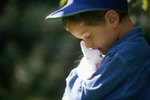
While sheep are not necessarily cold during shearing, they can develop cold stress afterward. Sheep wool keeps the animals insulated from the elements; shearing the wool removes some of their natural protection and makes it harder for the animals to self-regulate their body temperature. A cold sheep after shearing risks death from exposure to the elements, so keeping sheep warm is critical.
Significance
After shearing, sheep typically have about 3 millimeters -- less than 1/8 inch -- of fur. While this does offer some protection, sheep can become cold. At worst, sheep that develop cold stress after shearing can die from hypothermia. Sheep are at risk for hypothermia for up to one month after shearing; however, the first few days after shearing are the most risky. As the wool coat grows back, sheep have more protection against the cold.
Care
Cold stress develops in wet, chilly weather, especially if the weather changed from a drier, warmer condition to cool and wet. Even a summer rain could be problematic. After shearing and for up to one week after chilly weather, feed sheep up to 40 percent more than usual. The extra fuel helps them cope with cold. Keep the flock in a warm, dry area so they are protected from wind and rain. The flock will huddle together for warmth.
Signs of Hypothermia
When cold, sheep will seek shelter, huddle together and shiver to create body warmth. If you see sheep doing this, move them to a warm place to prevent the onset of hypothermia and provide food. As cold sheep develop hypothermia, they will begin to look lethargic and will rest on their chest or sides. The lining of the sheep's mouth will change from pink to white and the sheep's legs will feel cold.
Type
While all types of sheep are susceptible to cold after being shorn, young sheep are at higher risk. They are less likely to have put on body fat that can insulate them from the cold. Sheep that are losing weight are likewise more susceptible than those maintaining or gaining pounds. Sheep shorn in the fall are more likely to get chilled than those shorn in spring or summer, partly because fall weather is more likely to be chilly.
References
Photo Credits
-
Jupiterimages/Photos.com/Getty Images
Writer Bio
A successful website writer since 1998, Elton Dunn has demonstrated experience with technology, information retrieval, usability and user experience, social media, cloud computing, and small business needs. Dunn holds a degree from UCSF and formerly worked as professional chef. Dunn has ghostwritten thousands of blog posts, newsletter articles, website copy, press releases and product descriptions. He specializes in developing informational articles on topics including food, nutrition, fitness, health and pets.




